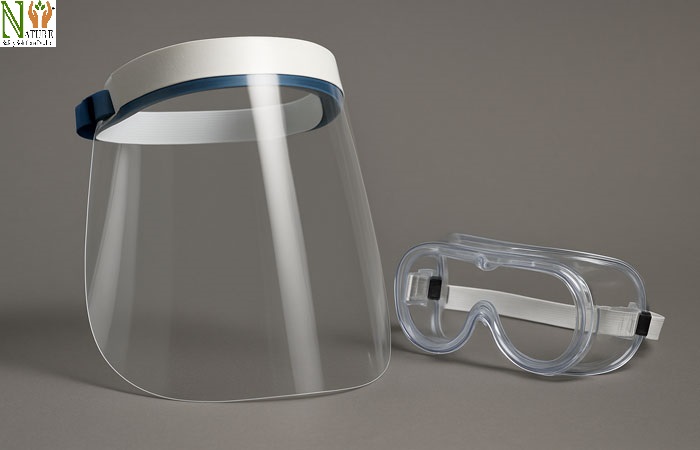Personal Protective Equipment (PPE) is critical for safeguarding individuals from hazardous environments, infectious diseases, and industrial risks. Among its components, face shields and goggles provide essential protection for the face and eyes—two of the most vulnerable parts of the body.
Whether in healthcare, chemical industries, construction, or laboratories, these protective gears form the first line of defense against harmful particles, chemical splashes, and infections. Understanding their design, purpose, and history helps us appreciate their importance in ensuring maximum safety.

Face Shield: Full-Face Barrier
What is a Face Shield?
A face shield is a transparent, curved sheet of plastic that covers the entire face, including the eyes, nose, and mouth. It is usually attached to a headband or helmet and designed to provide wide coverage without obstructing vision. Unlike masks, which only cover the mouth and nose, face shields protect the entire facial area from droplets, splashes, and debris.
History of the Face Shield
Face shields were first introduced in the early 20th century for industrial workers to protect against flying debris and sparks. During the 1910s, medical professionals began using them to prevent infections during surgeries.
The demand for face shields increased significantly during global health crises. They were widely used during the 1918 influenza pandemic. More recently, they became a crucial barrier for healthcare workers during the COVID-19 pandemic.
Key Features of Face Shields
- Wide Coverage: Extends from the forehead down to below the chin, offering full-face protection.
- Material Strength: Typically made from polycarbonate or PET plastic, which is lightweight yet durable.
- Anti-Fog Design: Many face shields include an anti-fog coating for clear visibility during extended use.
- Comfortable Fit: Adjustable headbands and foam padding make them suitable for long working hours.
Uses of Face Shields
- Healthcare Settings: Protects doctors, nurses, and lab technicians from infectious droplets during treatments and procedures.
- Industrial Work: Shields workers from sparks, flying debris, or chemical splashes.
- Public Safety: Used alongside masks for added protection during pandemics like COVID-19.
- Goggles: Focused Eye Protection
What are Goggles?
Goggles are protective eyewear that fits tightly around the eyes, forming a sealed barrier against harmful substances. They are designed for environments where there is a high risk of eye injury due to dust, chemicals, or impact from fast-moving objects.
History of Goggles
The earliest goggles were developed in the 13th century. They were mainly used as protective eyewear for blacksmiths and craftsmen. Modern industrial goggles appeared in the late 19th century.
Significant improvements were made during World War I and World War II, when soldiers needed better eye protection from debris and chemical gases. Today, advanced materials and anti-fog technology make goggles safer and more comfortable for many uses.
Key Features of Goggles
- Sealed Fit: Unlike regular glasses, goggles prevent harmful particles or liquids from entering the eye area.
- Durable Lenses: Made from shatter-resistant materials like polycarbonate to withstand impacts.
- Ventilation Options: Some goggles have indirect vents that allow airflow without compromising protection.
- Anti-Fog Technology: Maintains clear vision in humid or high-temperature environments.
Uses of Goggles
- Laboratories: Protect scientists and technicians from chemical splashes during experiments.
- Construction and Manufacturing: Shields eyes from dust, sparks, and flying debris.
- Medical Applications: Prevents exposure to infectious fluids during close contact procedures.
Face Shield vs. Goggles: Which to Choose?
The choice between a face shield and goggles depends on the level and type of exposure. Face shields are ideal for scenarios requiring full-face protection, while goggles are better suited for situations where precise eye safety is the priority. In high-risk environments, they are often used together—goggles for eye protection underneath, and a face shield as an added layer of defense.
Care and Maintenance
Both face shields and goggles need to be cleaned and disinfected after every use to maintain their effectiveness. Scratched or cracked surfaces should be replaced immediately, as they can reduce visibility and compromise safety. Proper storage in a clean, dry place ensures they remain in good condition for repeated use.
Also read:-
